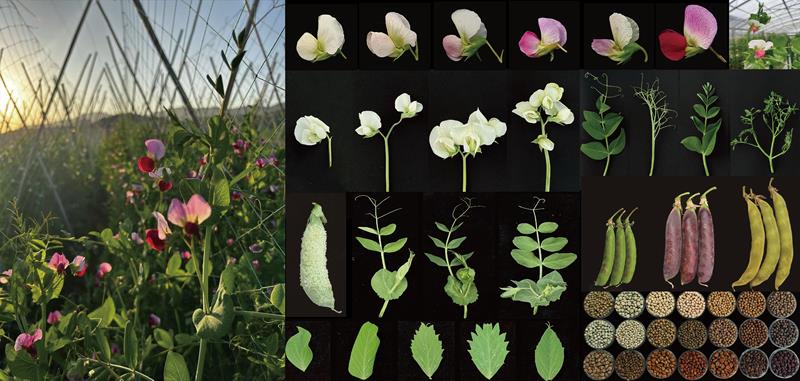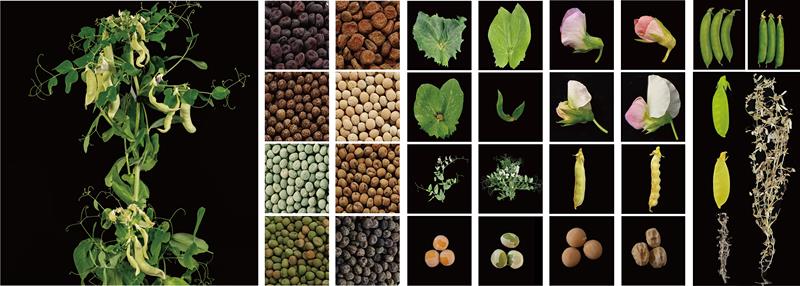After 160 years, Chinese scientists solved Mendel’s "pea mystery"
Why are some peas smooth and others wrinkled? Why are some peas yellow and some green? Why do some peas grow tall while others are short? Why are some pea flowers connected in ribbons?
These seemingly ordinary questions are the most famous topics in modern genetics. 160 years ago, gregor Mendel, the "father of modern genetics", started from seven pairs of pea traits, such as seed shape and color, and opened the door to genetic inheritance for the world. However, limited by the times and technology, Mendel, who discovered the biological genetic code, never really solved the hidden truth of the code, leaving the questions to future generations.
In the past 160 years, scientists have gone wave after wave, but three of the seven pairs of traits have not been completely solved.
Recently, Cheng Shifeng’s team from Shenzhen Institute of Agricultural Genome of Chinese Academy of Agricultural Sciences (Guangdong Laboratory of Lingnan Modern Agricultural Science and Technology, Shenzhen Branch), together with the team from John Innes Center in the UK, fully revealed the genetic basis behind the variation of seven traits of Mendel pea at the molecular level for the first time, and completed a cross-century scientific dialogue. The research results were published in Nature magazine.

Cheng Shifeng, researcher, Shenzhen Institute of Agricultural Genomics, Chinese Academy of Agricultural Sciences. Photo courtesy of Shenzhen Institute of Agricultural Genomics, Chinese Academy of Agricultural Sciences
Open the genetic door, but leave a 160-year puzzle.
In 1865, gregor Mendel, who was 43 years old, read a paper-"Experiment of Plant Hybridization" at a general lecture of the Austrian Natural History Society in Brno. In the paper, Mendel tells a discovery that was unknown at that time. The creatures are the same from generation to generation, but there are often special cases. What kind of changes and invariance are hidden in it? What kind of power dominates the genetic changes of living things?
He explored and studied more than ten kinds of plants, trying to find the law of biological inheritance, and finally chose pea, which is self-pollinated, with obvious floral organs and easy to cross and cultivate, and became his ideal experimental material. From this, he carried out research for 10 years. In the first two years of pre-experiment, through repeated observation and strict verification, he selected 22 homozygous pea varieties, and determined the following seven pairs of opposite characters: seed shape and stable inheritance.
Through nearly 300 hybridization experiments, the phenotypic records of more than 28,000 pea progeny, including the accurate counting and analysis of more than 14,000 seeds, Mendel found that each pair of traits was inherited in a distinct way of "dominant/recessive" two-state separation, and the traits that were temporarily "disappeared" in heterozygotes would reappear in the offspring in a predictable proportion. When multiple traits are inherited at the same time, he found that these traits follow the combination law of polynomial expansion and show a high degree of "regularity", which is amazing. These laws were later called "Mendel’s Law", which became the cornerstone of modern genetics and also known as "heritable miracle".
Unfortunately, restricted by the times and technology, Mendel discovered the secret of heredity, but never solved the principle behind these heredity and changes, leaving the opportunity to solve the mystery of the seven characteristics of peas to future generations.
Seven genetic codes, three to be solved.
In fact, in that speech 160 years ago, Mendel’s paper was rarely talked about. However, it is undeniable that this paper has opened the door to modern genetics, made people understand the vision of nature, penetrated into the microscopic world invisible to the naked eye for the first time, and thus spied the ultimate source of biodiversity.
Until as time went on, Mendel opened the door and attracted more and more scientists. Gene, a field that can explore the ultimate secrets of nature, has gradually become the hottest academic field.
It was not until 1917 that the genes of the seven opposite traits put forward by Mendel were formally named, and their positions on chromosomes were realized one after another. But in recent decades, with the development of molecular genetics, candidate genes for some traits have been confirmed one after another.
Cheng Shifeng introduced that in 1990, a paper published in Cell reported for the first time that the gene controlling pea grain shape differences, such as round or wrinkled grains, was SBEI amylopectin I type. In 1997, "Plant Cell" and "Proceedings of the National Academy of Sciences (PNAS)" published research independently, confirming that plant height, such as tall or short, is controlled by a gene named GA3ox1. In 2007, two articles in Science and Proceedings of the National Academy of Sciences (PNAS) independently revealed that the color difference of seeds, such as yellow grains or green grains, was caused by the mutation of a gene named Stay-green. In 2010, a study in PLOS ONE compared with the homologous genes of alfalfa, and found that it is a kind of bHLH transcription factor that controls color changes such as purple flowers or white flowers.
However, the genetic variation of three key traits has not been solved, namely, pod color, pod shape and flower position. Cheng Shifeng introduced that many candidate genes and hypotheses have been put forward in the academic circles, but they were all overturned due to lack of conclusive molecular evidence. The genes behind these traits, like "ghosts" in the genome, are hidden and difficult to capture.
Collecting Global Resources and Rebuilding Mendel Pea Garden
In 2019, Cheng Shifeng is working hard to find an ideal leguminous model system to study the genetic mechanism of symbiotic nitrogen fixation. When he visited the germplasm resource bank of John Innes Center in England, he saw a batch of precious pea germplasm resources, which were mainly collected in the European continent, where the story of Mendel, the father of genetics, was most easily remembered by breeders.
"Mendel, genetics, seven traits … stories that were familiar to me as a student suddenly surged from my memory in front of these ancient peas." Cheng Shifeng said, "It is a pity that after more than one hundred years, nearly half of the genes behind the genetic variation of the seven pea traits have not been discovered."
Cheng Shifeng decided to learn from the pioneers of genetics and take peas as the research object. He is going to introduce global pea germplasm resources, rebuild a modern version of "Mendel Pea Garden" in Shenzhen, and use modern science and technology to pursue the answers to the century-old puzzles of seven pea traits while conducting research on leguminous nodulation and nitrogen fixation.
This is a difficult task. As countries pay more attention to and protect germplasm resources, international exchanges and cooperation need to overcome many barriers. Fortunately, after many difficulties, about 700 pea core germplasm from 41 countries on six continents traveled to Wan Li, crossed the ocean, landed in China one year later, and quickly carried out planting and phenotypic recording in many experimental bases such as Shenzhen and Harbin.

Pea planted in Shenzhen germplasm resources garden showed rich phenotypic diversity. Photo courtesy of Shenzhen Institute of Agricultural Genomics, Chinese Academy of Agricultural Sciences
In the following five years, the research team investigated more than 80 agronomic traits and excavated a large number of important genetic variations related to flowering period, plant type, organ size, pod number and other traits.
"When the beautiful butterfly flowers bloom in the north and south of China, when those purple-flowered, round-grained, short-stemmed, wrinkled peas grow quietly in the garden, a personality in Mendel’s hybridization experiment seems to have crossed time and space and suddenly appeared before our eyes. If Mendel’s 1865 paper was a love letter to the future world, it was once forgotten and misunderstood; So today, we wrote a letter to Mendel with the technology and enthusiasm of the 21st century. " Cheng Shifeng said.
See the world from a corner and untie peas.Century puzzle
Modern genetics is a young discipline, with a history of 160 years, which makes it appear immature among many disciplines, but it does not hinder its outstanding position and become the jewel in the laurels of modern science.
Compared with the history of 160 years, the research of Cheng Shifeng’s team for five consecutive years is not long, but it is wonderful and difficult. "The types of genetic variation behind Mendel’s seven opposing traits are far more diverse than people think: from single base mutation to DNA deletion of different sizes, from active transposon insertion to complex transcription fusion, covering a variety of common mutation mechanisms and genetic metabolic pathways in nature. The revelation of most mutation mechanisms is not a fuzzy statistical correlation, but a clear and traceable causal relationship, which is a classic example to understand the change from sequence variation to phenotype. What is even more surprising is that almost all of these mutations are characterized by functional loss or weakening, and a clear definition of’ dominance’ and’ recessive’ at the molecular level is constructed: dominance is functional integrity, while recessive often stems from functional loss or regulatory imbalance. "
Fortunately, the team finally uncovered the secrets of the last three opposing traits. They found that it was not the genetic mutation in the traditional sense that controlled the difference between yellow and green color of fruit pods, but the deletion of a large genome segment of about 100kb. It is two independent but functionally related genes that control the fullness and shrinkage of fruit pods. The position of pea flower "banding", the most complicated and mysterious of Mendel’s seven traits variation, is controlled by a gene named Fa.
So far, the "century puzzle" of three major traits, namely yellow pod, wrinkled pod and banding, and four genes has been solved one by one, and the research team systematically analyzed the genetic basis of all seven opposite traits of peas studied by Mendel 160 years ago at the molecular level.
On an aesthetic journey, science always has surprises.
Scientific research is difficult and long, but there are always unexpected surprises. Cheng Shifeng introduced that in the process of analyzing the seven opposing traits, more plant color beauty was discovered, and behind it, there was a set of precise genetic and metabolic codes. Unlocking this code seemed to be not a scientific research, but a beautiful appreciation.
In the study of the mysterious pea banding character, the research team also accidentally discovered a new genetic modification site under another chromosome. Cheng Shifeng introduced that this locus, like Andhadhun who quietly plucked the strings, or the co-pilot who stepped on the brakes, changed the genetic script of a mutant of the terminal flower in running all the way. Even if the plant carries the mutant of double recessive fa/fa, because it has the homozygous genotype of mfa/mfa at the same time, "destiny takes a hand" should show a banded terminal flower phenotype, which is completely or partially inhibited, and the plant reverts to the appearance of wild-type "lateral flower". The only inconsistency between the phenotype and genotype of the top flower is perfectly explained. This inconsistency is called "incomplete penetrance" and "variable expression" in genetics. Mfa does not change the coding function of the major gene Fa, but changes the final phenotypic presentation by delaying, weakening or covering up its mutation effect, so that the original "inevitable" performance becomes a "probable" choice. This mechanism of "major mutation of genetic background modification" provides a vivid case for understanding the phenotypic plasticity and genetic regulation level behind complex traits.
Today, the research team continues to analyze many complex traits, including organ size, flowering time and stem color investigated by Mendel, as well as agronomic traits with important breeding value, such as pod number, yield, nodulation and root structure, so as to provide more optional materials for future precision breeding.
Crossing a century of time and space, talking to sages on the road of science
The five-year research began with an accidental encounter, but Cheng Shifeng felt that it might be inevitable, just like those fascinating changes in the genetic world, which seem accidental but inevitable, obviously inevitable, but unexpected changes will occur at any time.

Phenotypic diversity of seven pairs of pea characters. Photo courtesy of Shenzhen Institute of Agricultural Genomics, Chinese Academy of Agricultural Sciences
"Mendel’s paper" Plant Hybridization Experiment "is known as" the best scientific experiment in human history ".He studied the flow of" information "in different generations with clear questions, careful experimental design, rigorous data analysis and highly logical deduction process, and gained insight into the behavior of genetic factors in germ cells. In that era without chromosomes and DNA, he predicted that heritable variation was the source of biodiversity and the raw material of natural selection in species evolution. " Cheng Shifeng said.
Until the paper was written, Cheng Shifeng was still attracted by this earth-shattering change 160 years ago. After 160 years, science and technology have leapt to this day, from microscope to high-throughput sequencing, from character observation to multi-group analysis. "We finally got to understand the origin, expression and inheritance of those seven pairs of characters at the molecular, structural, development, evolution and even the whole system level."
In Mendel’s time, his discovery did not attract enough attention. It was not until 16 years after his death-35 years after his paper was read out in 1900 that Mendel’s work was rediscovered.
Mendel once predicted, "My time will come." Cheng Shifeng said, "Now, this era has already arrived."
Beijing News reporter Zhou Huaizong
Editor Zhang Shujing proofreads Fu Chuncheng.